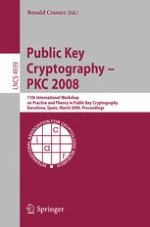2008 | Buch
Public Key Cryptography – PKC 2008
11th International Workshop on Practice and Theory in Public-Key Cryptography, Barcelona, Spain, March 9-12, 2008. Proceedings
herausgegeben von: Ronald Cramer
Verlag: Springer Berlin Heidelberg
Buchreihe : Lecture Notes in Computer Science
